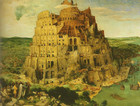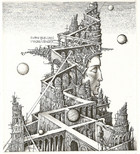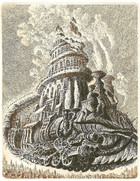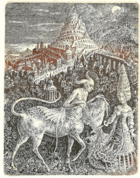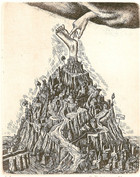Pieter Bruegel the Elder
The Tower of Babel (1563)
Oil on panel
In his oil painting of the Tower of Babel, 16th Century Netherlandish Painter Pieter Bruegel created an image of human striving, based on the biblical narrative in Genesis 11:1-9, which has intrigued art-makers down the centuries. His multi-leveled, unfinished structure, modeled on the Coliseum in Rome (with its associations to pagan decadence and Christian martyrdom) dwarfs everything beside it, a monstrous eyesore in the pre-industrial landscape.
This extravagance in stone may seem, at first glance, to be a marvel of scientific engineering, but on closer examination it lacks any unifying design. The tower touches the clouds, but the red brick extension at the top appears to correct a tilt in the original structure. You might well wonder how firm a foundation was laid here!
Bruegel's contemporaries would have immediately understood the biblical moral, viewing this monstrous architectural mass as a symbol of human folly, spiritual disobedience and overweening pride. Artists in an age of vulnerable skyscrapers tend to appropriate Bruegel's Babel image more as a generalized emblem of the human enterprise, both serious and sardonic. There are four interesting modern variations on the Tower of Babel theme in my collection, all the work, curiously enough, of East European ex-libris makers.
Belorus Graphic Artist Roman Sustov personifies the tower as a crustacean-like figure of delicate profile and closed eyes, whose architectural outcroppings recall the rampways in the prison prints of 18th Century Italian Artist Giovanni Piranesi. There seems to be no God in this heaven. The title of the print says it all: Loneliness. Another Belorus, Ivan Rusachek, creates an apocalyptic vision of an embattled citadel, soon to be engulfed by waves, while an indifferent face, watches from the heavens above. Lithuanian Print-Maker Marius Liugaila all but strangles the tower with a speeding, horned, python-like train and turns it into a fantasical icon of fashion. Czech Artist Jindrich Pilecek tops the Bruegel borrowing with another sacred art reference. In a whimsical take on Michelangelo's famous fresco of the Creation of Adam in the Sistine Chapel, a Divine Finger extends to tickle the sole of a foot, sticking up from a Bruegel-styled mound.
